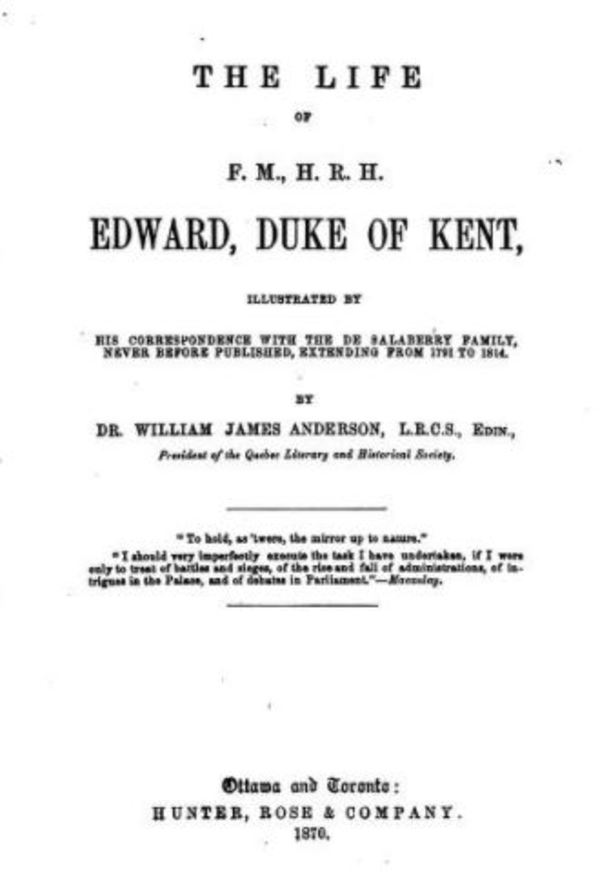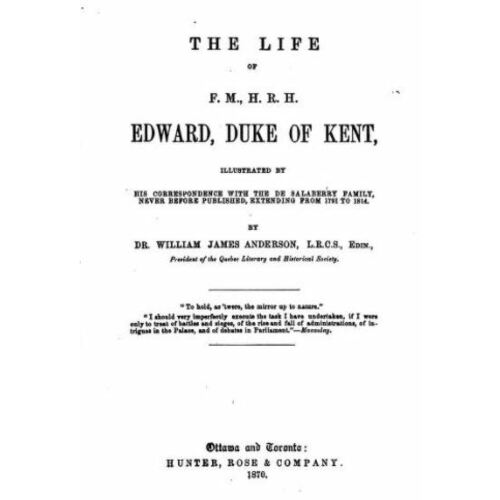
Source: Link
ANDERSON, WILLIAM JAMES, physician, amateur geologist, and historian; b. 2 Nov. 1812 at sea off the Danish coast, to Scottish parents; d. 15 May 1873 in Quebec City of tuberculosis. He was married and makes reference to a daughter.
William James Anderson studied medicine at Edinburgh, and held the degree of md and a lrcs. In the 1830s as a young emigrant doctor in the Maritimes, he fostered his taste for history by exploring Nova Scotia. At Chignecto Bay and South Joggins he investigated mining operations. Anderson’s health collapsed during a typhus epidemic in Pictou in 1847. He left the Maritimes and the medical profession and operated a sawmill in Borelia, Upper Canada. In the 1850s he moved on to Toronto.
After a brief return to mining districts in the Maritimes, he settled in Quebec City in 1860, resuming his profession. There his other interests took much of his attention. In 1862, through newspaper articles on gold-mining, he became acquainted with Dr James Douglas*, a fellow mining enthusiast and member of the Literary and Historical Society of Quebec. Dr Anderson led a group of members who revived the society, reanimated its interest in securing and publishing documents on Quebec, and re-established its library and museum. He himself first reported to the society in November 1863; his first papers in its Transactions were on the gold-fields of Nova Scotia and of the world, and the bitumen of Point de Lévy. He continued to publish in this subject area. On a visit to Nova Scotia in 1862 he had toured Acadian regions and inspected the Provincial Archives at Halifax.
In 1866 he began a series of major historical contributions in the Transactions of the Literary and Historical Society, with historiography a particular theme; these papers dealt with the life of the Duke of Kent, including letters from him held by the de Salaberry family (the son of Charles-Michel d’Irumberry* de Salaberry, the “Victor of Châteauguay,” had been one of Anderson’s patients); Evangeline (his paper’s subtitle, “The poetry and prose of history,” is an indication of the author’s approach); the capitulation of J.-B.-N.-R. de Ramezay* in 1759 (the essay explores closely differences between French and English accounts of the incident); and the siege of Quebec by Richard Montgomery* and Benedict Arnold* in 1775–76. In writing these essays Anderson made use of archival papers in Halifax, arranged for the transfer of others from Halifax to Quebec, and got archival materials transferred to Canada from Britain. While on the executive of the Literary and Historical Society, he fostered publication of two series of Historical documents (1866, 1871) and his last publication in 1872 advocated an archives for Canada. He was a friend of other historians of the confederation years: François-Xavier Garneau*, Jean-Baptiste-Antoine Ferland*, Philippe Aubert de Gaspé, and James MacPherson Le Moine*. As president of the society he brought it into contact with Francis Parkman*, Joseph Howe, and Louis-Joseph Papineau.
Obituaries refer to Anderson’s “dignified mien,” his “long beard frosted by suffering,” his “utterance measured slow,” and his Scottish humour. His many publications attest to his energy, his breadth of interest, and his penchant for historical research.
W. J. Anderson, “The archives of Canada,” and “Canadian history, the siege and blockade of Quebec, by Generals Montgomery and Arnold in 1775–1776,” in Lit. and Hist. Soc. of Quebec, Trans., new ser., IX (1872), 117, 49 (the second appeared as an off-print, Quebec, 1872); “Curiosities of Canadian literature: Washington and Jumonville,” Canadian Monthly and National Review (Toronto), III (1873), 55; “Evangeline and the archives of Nova Scotia,” Lit. and Hist. Soc. of Quebec, Trans., new ser., VII (1870), 5; “Gold fields of Nova Scotia,” Lit. and Hist. Soc. of Quebec, Trans., new ser., II (1864), 35; The gold-fields of the world, our knowledge of them, and its application to the gold fields of Canada (Quebec, 1864); The life of F.M., H.R.H. Edward, Duke of Kent, illustrated by his correspondence with the de Salaberry family, never before published, extending from 1791 to 1814 (Ottawa and Toronto, 1870); The lower St. Lawrence, its scenery, navigation and commerce, forming a complete tourist’s guide (Quebec, 1872); “Military operations at Quebec from the capitulation by De Ramesay on 18th September, 1759, to raising the siege by De Levis between the night of the 17th and the morning of the 18th May, 1760,” Lit. and Hist. Soc. of Quebec, Trans., new ser., VII (1870), iii; “On Canadian history and biography, and passages in the lives of a British prince and a Canadian seigneur,” Lit. and Hist. Soc. of Quebec, Trans., new ser., V (1867), 15; “On the coal-like substance or ‘altered Bitumen’ found in the excavations at Fort no. 3, Point Levis, and the presently accepted theories on the origin of coals, bitumens and petroleum springs, with an account of the ‘Carboniferous system’ of British North America,” Lit. and Hist. Soc. of Quebec, Trans., new ser., IV (1866), 19; “Opening address – ‘Review of the past year, moving accidents by flood and field’,” Lit. and Hist. Soc. of Quebec, Trans., new ser., VIII (1871), 5. [James Murray], Journal of the siege of Quebec, 1759–1760, by General Jas. Murray (Lit. and Hist. Soc. of Quebec, Historical Documents, D.6., 3rd ser., Quebec, 1871). Recueil de ce qui s’est passé en Canada au sujet de la guerre, tant des Anglais que des Iroquois, depuis l’année 1682 (Lit. and Hist. Soc. of Quebec, Historical Documents, D.6., 3rd ser., Quebec, 1871). Morning Chronicle (Quebec), 18 May 1873. Quebec Daily Mercury, 18 May 1873. The centenary volume of the Literary and Historical Society of Quebec, 1824–1924, ed. Henry Ievers (Quebec, 1924). Index to the lectures, papers, and historical documents published by the Literary and Historical Society of Quebec . . . , ed. F. C. Wurtele and J. W. Strachan (Quebec, 1927), 30, 46, 47. List of historical documents and new series of “Transactions” published by the Literary and Historical Society of Quebec (Quebec, 1927). Morgan, Bibliotheca Canadensis. “Les disparus, William-James Anderson,” BRH, XXXV (1929), 620.
Cite This Article
Elizabeth Waterston, “ANDERSON, WILLIAM JAMES,” in Dictionary of Canadian Biography, vol. 10, University of Toronto/Université Laval, 2003–, accessed January 8, 2026, https://www.biographi.ca/en/bio/anderson_william_james_10E.html.
The citation above shows the format for footnotes and endnotes according to the Chicago manual of style (16th edition). Information to be used in other citation formats:
| Permalink: | https://www.biographi.ca/en/bio/anderson_william_james_10E.html |
| Author of Article: | Elizabeth Waterston |
| Title of Article: | ANDERSON, WILLIAM JAMES |
| Publication Name: | Dictionary of Canadian Biography, vol. 10 |
| Publisher: | University of Toronto/Université Laval |
| Year of publication: | 1972 |
| Year of revision: | 1972 |
| Access Date: | January 8, 2026 |



